Strategic Evaluation of Sainsbury's: Strategies, Models & Change Mgt
VerifiedAdded on 2023/06/18
|14
|3935
|272
Report
AI Summary
This report provides a critical assessment of Sainsbury's strategic management, focusing on the processes used to determine their strategies and the application of models like VRIO, PESTLE, and Porter's Five Forces. It evaluates Sainsbury's vision, mission, and objectives, and how these are translated into strategic direction. The VRIO model is used to categorize resources and assess competitive advantages, while PESTLE analysis identifies external factors influencing Sainsbury's performance. Porter's Five Forces model is applied to analyze the competitive intensity within the industry. Furthermore, the report discusses the importance of change management, considering the complexity, costs, risks, and sustainability of transformation processes within Sainsbury's. The analysis highlights Sainsbury's strengths and weaknesses, providing insights into their strategic positioning and potential areas for improvement. Desklib provides more solved assignments and past papers for students.
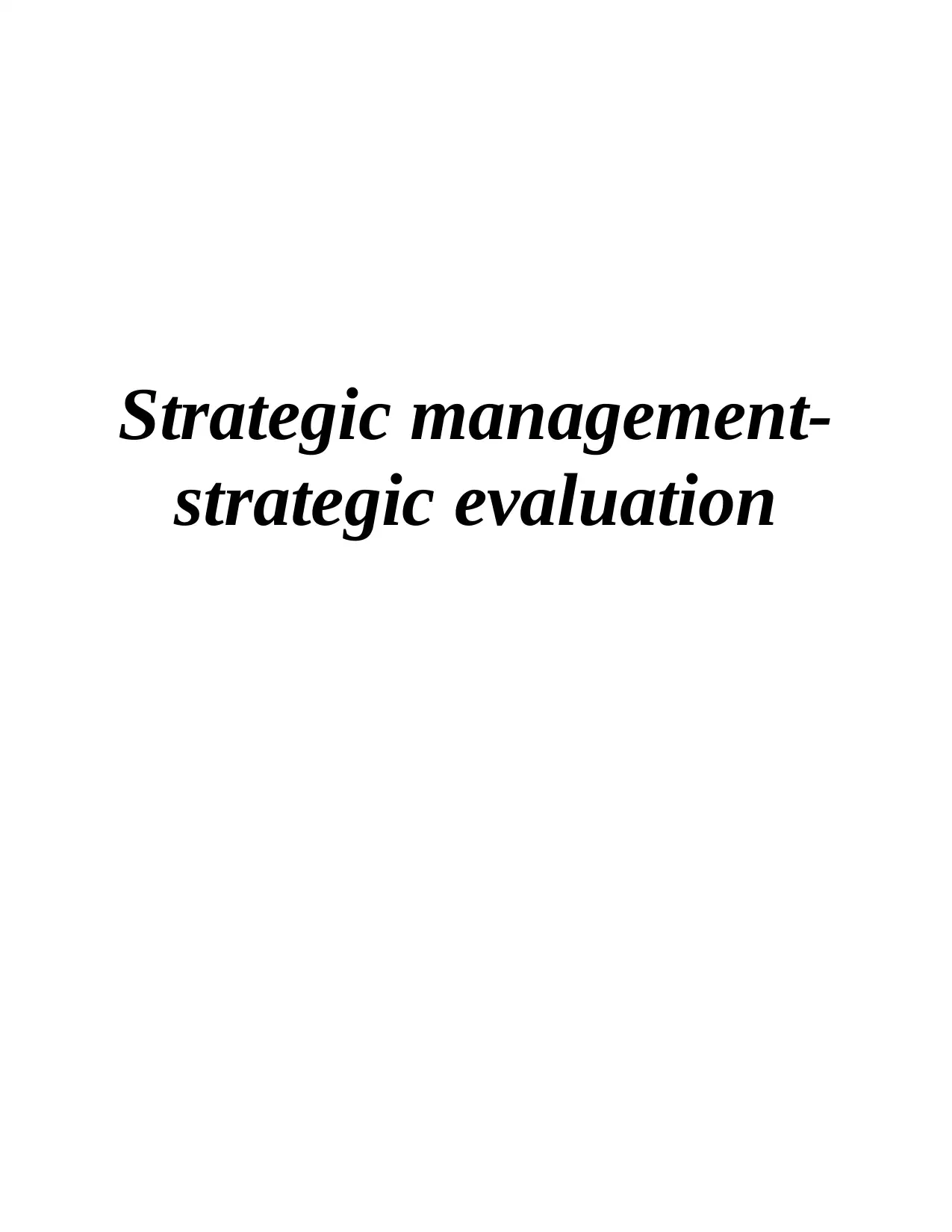
Strategic management-
strategic evaluation
strategic evaluation
Paraphrase This Document
Need a fresh take? Get an instant paraphrase of this document with our AI Paraphraser
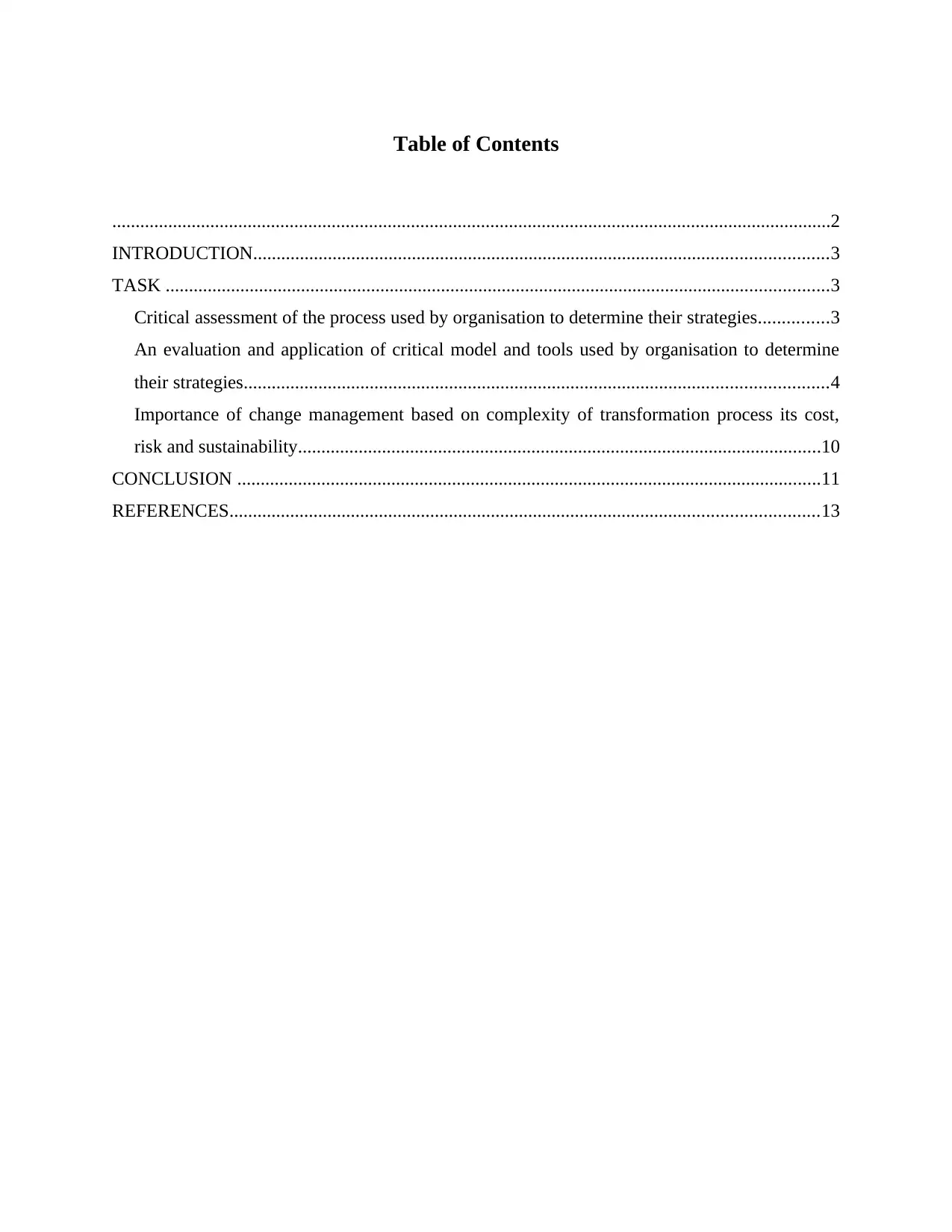
Table of Contents
..........................................................................................................................................................2
INTRODUCTION...........................................................................................................................3
TASK ..............................................................................................................................................3
Critical assessment of the process used by organisation to determine their strategies...............3
An evaluation and application of critical model and tools used by organisation to determine
their strategies.............................................................................................................................4
Importance of change management based on complexity of transformation process its cost,
risk and sustainability................................................................................................................10
CONCLUSION .............................................................................................................................11
REFERENCES..............................................................................................................................13
..........................................................................................................................................................2
INTRODUCTION...........................................................................................................................3
TASK ..............................................................................................................................................3
Critical assessment of the process used by organisation to determine their strategies...............3
An evaluation and application of critical model and tools used by organisation to determine
their strategies.............................................................................................................................4
Importance of change management based on complexity of transformation process its cost,
risk and sustainability................................................................................................................10
CONCLUSION .............................................................................................................................11
REFERENCES..............................................................................................................................13

⊘ This is a preview!⊘
Do you want full access?
Subscribe today to unlock all pages.

Trusted by 1+ million students worldwide
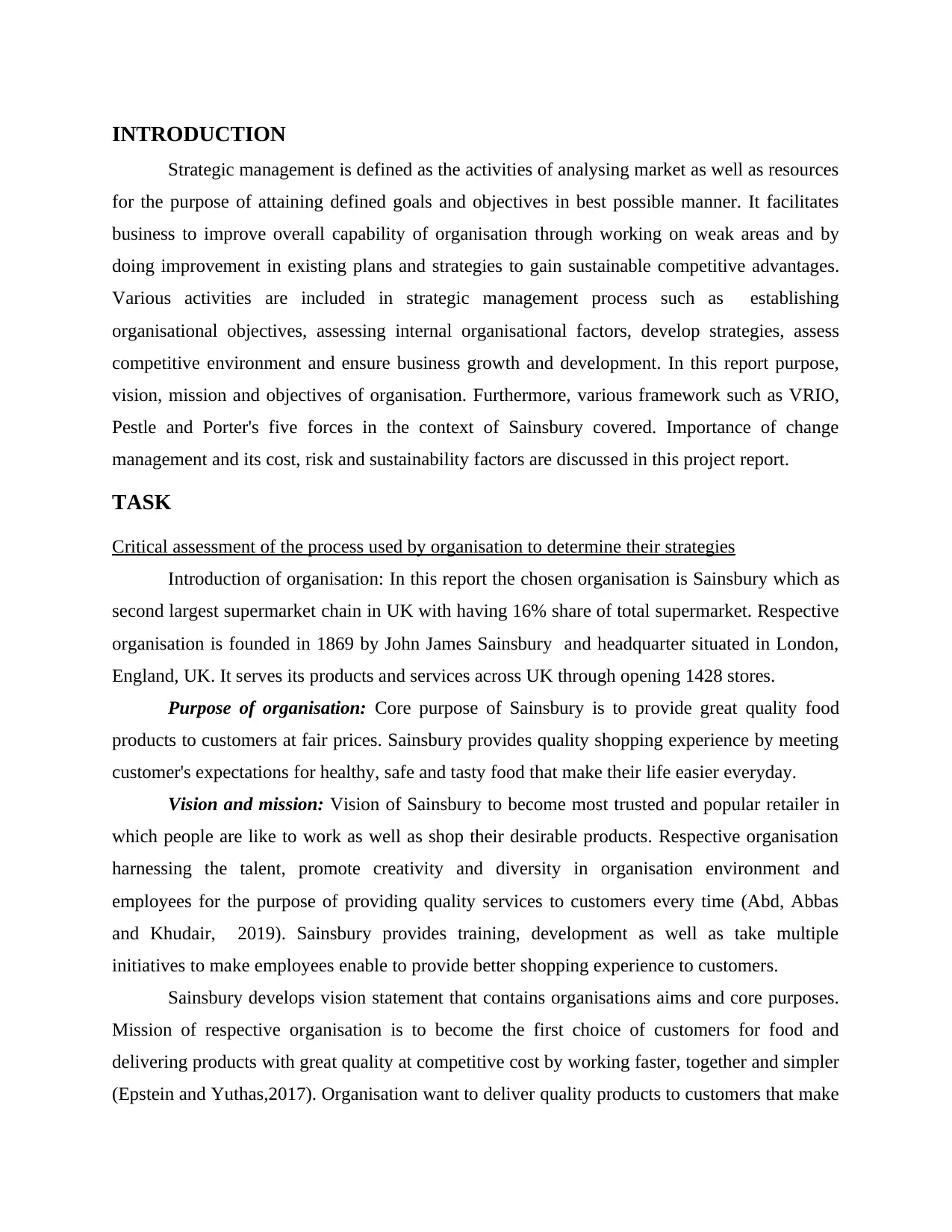
INTRODUCTION
Strategic management is defined as the activities of analysing market as well as resources
for the purpose of attaining defined goals and objectives in best possible manner. It facilitates
business to improve overall capability of organisation through working on weak areas and by
doing improvement in existing plans and strategies to gain sustainable competitive advantages.
Various activities are included in strategic management process such as establishing
organisational objectives, assessing internal organisational factors, develop strategies, assess
competitive environment and ensure business growth and development. In this report purpose,
vision, mission and objectives of organisation. Furthermore, various framework such as VRIO,
Pestle and Porter's five forces in the context of Sainsbury covered. Importance of change
management and its cost, risk and sustainability factors are discussed in this project report.
TASK
Critical assessment of the process used by organisation to determine their strategies
Introduction of organisation: In this report the chosen organisation is Sainsbury which as
second largest supermarket chain in UK with having 16% share of total supermarket. Respective
organisation is founded in 1869 by John James Sainsbury and headquarter situated in London,
England, UK. It serves its products and services across UK through opening 1428 stores.
Purpose of organisation: Core purpose of Sainsbury is to provide great quality food
products to customers at fair prices. Sainsbury provides quality shopping experience by meeting
customer's expectations for healthy, safe and tasty food that make their life easier everyday.
Vision and mission: Vision of Sainsbury to become most trusted and popular retailer in
which people are like to work as well as shop their desirable products. Respective organisation
harnessing the talent, promote creativity and diversity in organisation environment and
employees for the purpose of providing quality services to customers every time (Abd, Abbas
and Khudair, 2019). Sainsbury provides training, development as well as take multiple
initiatives to make employees enable to provide better shopping experience to customers.
Sainsbury develops vision statement that contains organisations aims and core purposes.
Mission of respective organisation is to become the first choice of customers for food and
delivering products with great quality at competitive cost by working faster, together and simpler
(Epstein and Yuthas,2017). Organisation want to deliver quality products to customers that make
Strategic management is defined as the activities of analysing market as well as resources
for the purpose of attaining defined goals and objectives in best possible manner. It facilitates
business to improve overall capability of organisation through working on weak areas and by
doing improvement in existing plans and strategies to gain sustainable competitive advantages.
Various activities are included in strategic management process such as establishing
organisational objectives, assessing internal organisational factors, develop strategies, assess
competitive environment and ensure business growth and development. In this report purpose,
vision, mission and objectives of organisation. Furthermore, various framework such as VRIO,
Pestle and Porter's five forces in the context of Sainsbury covered. Importance of change
management and its cost, risk and sustainability factors are discussed in this project report.
TASK
Critical assessment of the process used by organisation to determine their strategies
Introduction of organisation: In this report the chosen organisation is Sainsbury which as
second largest supermarket chain in UK with having 16% share of total supermarket. Respective
organisation is founded in 1869 by John James Sainsbury and headquarter situated in London,
England, UK. It serves its products and services across UK through opening 1428 stores.
Purpose of organisation: Core purpose of Sainsbury is to provide great quality food
products to customers at fair prices. Sainsbury provides quality shopping experience by meeting
customer's expectations for healthy, safe and tasty food that make their life easier everyday.
Vision and mission: Vision of Sainsbury to become most trusted and popular retailer in
which people are like to work as well as shop their desirable products. Respective organisation
harnessing the talent, promote creativity and diversity in organisation environment and
employees for the purpose of providing quality services to customers every time (Abd, Abbas
and Khudair, 2019). Sainsbury provides training, development as well as take multiple
initiatives to make employees enable to provide better shopping experience to customers.
Sainsbury develops vision statement that contains organisations aims and core purposes.
Mission of respective organisation is to become the first choice of customers for food and
delivering products with great quality at competitive cost by working faster, together and simpler
(Epstein and Yuthas,2017). Organisation want to deliver quality products to customers that make
Paraphrase This Document
Need a fresh take? Get an instant paraphrase of this document with our AI Paraphraser
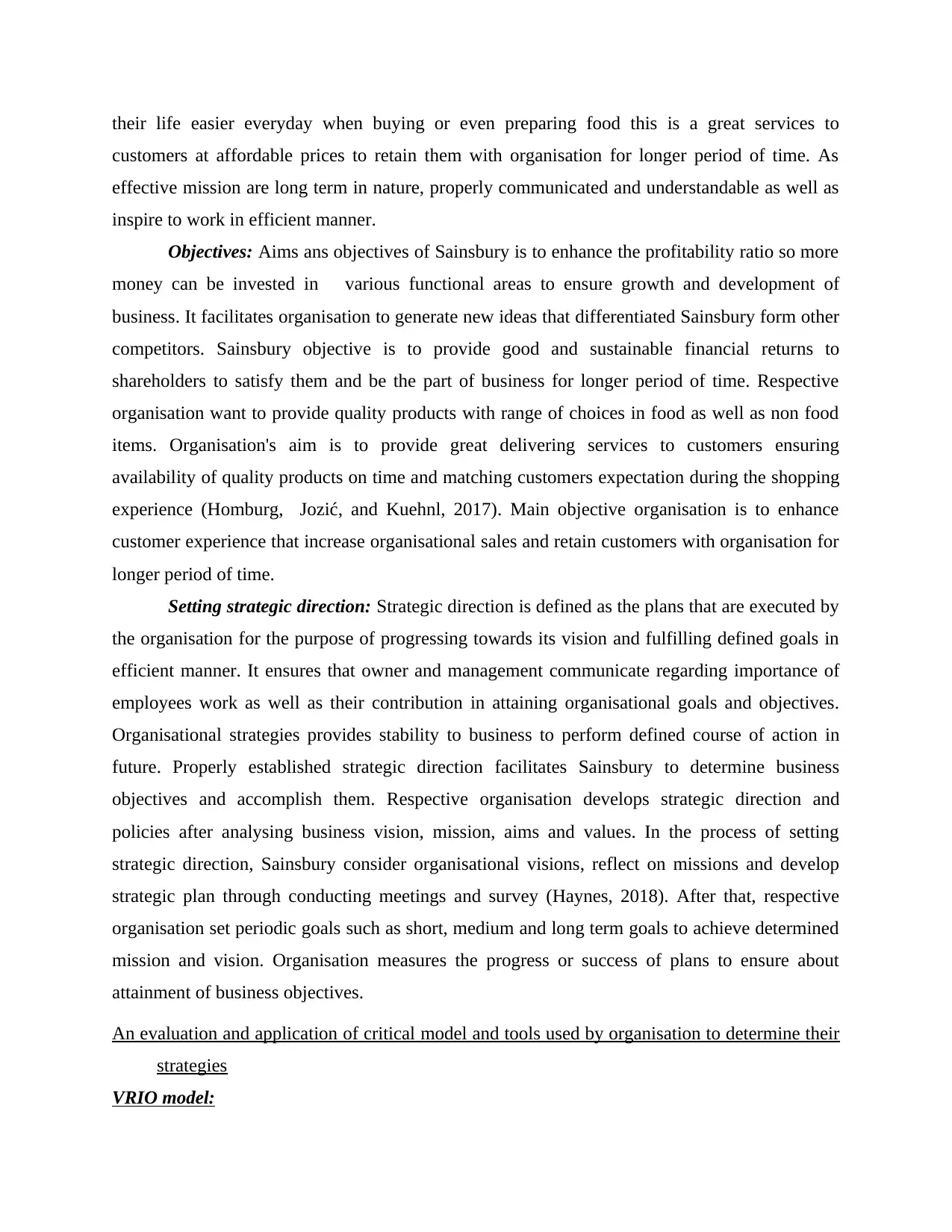
their life easier everyday when buying or even preparing food this is a great services to
customers at affordable prices to retain them with organisation for longer period of time. As
effective mission are long term in nature, properly communicated and understandable as well as
inspire to work in efficient manner.
Objectives: Aims ans objectives of Sainsbury is to enhance the profitability ratio so more
money can be invested in various functional areas to ensure growth and development of
business. It facilitates organisation to generate new ideas that differentiated Sainsbury form other
competitors. Sainsbury objective is to provide good and sustainable financial returns to
shareholders to satisfy them and be the part of business for longer period of time. Respective
organisation want to provide quality products with range of choices in food as well as non food
items. Organisation's aim is to provide great delivering services to customers ensuring
availability of quality products on time and matching customers expectation during the shopping
experience (Homburg, Jozić, and Kuehnl, 2017). Main objective organisation is to enhance
customer experience that increase organisational sales and retain customers with organisation for
longer period of time.
Setting strategic direction: Strategic direction is defined as the plans that are executed by
the organisation for the purpose of progressing towards its vision and fulfilling defined goals in
efficient manner. It ensures that owner and management communicate regarding importance of
employees work as well as their contribution in attaining organisational goals and objectives.
Organisational strategies provides stability to business to perform defined course of action in
future. Properly established strategic direction facilitates Sainsbury to determine business
objectives and accomplish them. Respective organisation develops strategic direction and
policies after analysing business vision, mission, aims and values. In the process of setting
strategic direction, Sainsbury consider organisational visions, reflect on missions and develop
strategic plan through conducting meetings and survey (Haynes, 2018). After that, respective
organisation set periodic goals such as short, medium and long term goals to achieve determined
mission and vision. Organisation measures the progress or success of plans to ensure about
attainment of business objectives.
An evaluation and application of critical model and tools used by organisation to determine their
strategies
VRIO model:
customers at affordable prices to retain them with organisation for longer period of time. As
effective mission are long term in nature, properly communicated and understandable as well as
inspire to work in efficient manner.
Objectives: Aims ans objectives of Sainsbury is to enhance the profitability ratio so more
money can be invested in various functional areas to ensure growth and development of
business. It facilitates organisation to generate new ideas that differentiated Sainsbury form other
competitors. Sainsbury objective is to provide good and sustainable financial returns to
shareholders to satisfy them and be the part of business for longer period of time. Respective
organisation want to provide quality products with range of choices in food as well as non food
items. Organisation's aim is to provide great delivering services to customers ensuring
availability of quality products on time and matching customers expectation during the shopping
experience (Homburg, Jozić, and Kuehnl, 2017). Main objective organisation is to enhance
customer experience that increase organisational sales and retain customers with organisation for
longer period of time.
Setting strategic direction: Strategic direction is defined as the plans that are executed by
the organisation for the purpose of progressing towards its vision and fulfilling defined goals in
efficient manner. It ensures that owner and management communicate regarding importance of
employees work as well as their contribution in attaining organisational goals and objectives.
Organisational strategies provides stability to business to perform defined course of action in
future. Properly established strategic direction facilitates Sainsbury to determine business
objectives and accomplish them. Respective organisation develops strategic direction and
policies after analysing business vision, mission, aims and values. In the process of setting
strategic direction, Sainsbury consider organisational visions, reflect on missions and develop
strategic plan through conducting meetings and survey (Haynes, 2018). After that, respective
organisation set periodic goals such as short, medium and long term goals to achieve determined
mission and vision. Organisation measures the progress or success of plans to ensure about
attainment of business objectives.
An evaluation and application of critical model and tools used by organisation to determine their
strategies
VRIO model:
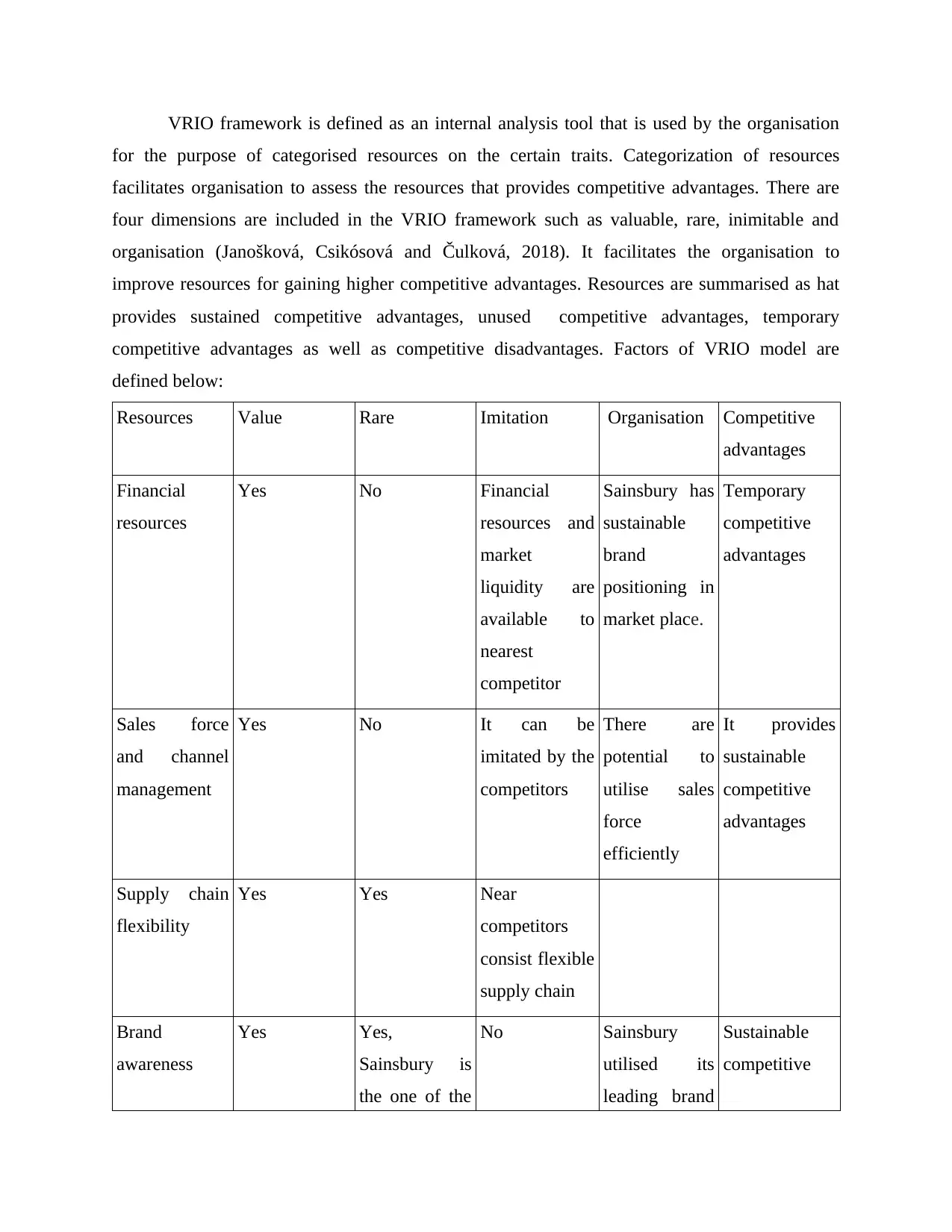
VRIO framework is defined as an internal analysis tool that is used by the organisation
for the purpose of categorised resources on the certain traits. Categorization of resources
facilitates organisation to assess the resources that provides competitive advantages. There are
four dimensions are included in the VRIO framework such as valuable, rare, inimitable and
organisation (Janošková, Csikósová and Čulková, 2018). It facilitates the organisation to
improve resources for gaining higher competitive advantages. Resources are summarised as hat
provides sustained competitive advantages, unused competitive advantages, temporary
competitive advantages as well as competitive disadvantages. Factors of VRIO model are
defined below:
Resources Value Rare Imitation Organisation Competitive
advantages
Financial
resources
Yes No Financial
resources and
market
liquidity are
available to
nearest
competitor
Sainsbury has
sustainable
brand
positioning in
market place.
Temporary
competitive
advantages
Sales force
and channel
management
Yes No It can be
imitated by the
competitors
There are
potential to
utilise sales
force
efficiently
It provides
sustainable
competitive
advantages
Supply chain
flexibility
Yes Yes Near
competitors
consist flexible
supply chain
Brand
awareness
Yes Yes,
Sainsbury is
the one of the
No Sainsbury
utilised its
leading brand
Sustainable
competitive
for the purpose of categorised resources on the certain traits. Categorization of resources
facilitates organisation to assess the resources that provides competitive advantages. There are
four dimensions are included in the VRIO framework such as valuable, rare, inimitable and
organisation (Janošková, Csikósová and Čulková, 2018). It facilitates the organisation to
improve resources for gaining higher competitive advantages. Resources are summarised as hat
provides sustained competitive advantages, unused competitive advantages, temporary
competitive advantages as well as competitive disadvantages. Factors of VRIO model are
defined below:
Resources Value Rare Imitation Organisation Competitive
advantages
Financial
resources
Yes No Financial
resources and
market
liquidity are
available to
nearest
competitor
Sainsbury has
sustainable
brand
positioning in
market place.
Temporary
competitive
advantages
Sales force
and channel
management
Yes No It can be
imitated by the
competitors
There are
potential to
utilise sales
force
efficiently
It provides
sustainable
competitive
advantages
Supply chain
flexibility
Yes Yes Near
competitors
consist flexible
supply chain
Brand
awareness
Yes Yes,
Sainsbury is
the one of the
No Sainsbury
utilised its
leading brand
Sustainable
competitive
⊘ This is a preview!⊘
Do you want full access?
Subscribe today to unlock all pages.

Trusted by 1+ million students worldwide
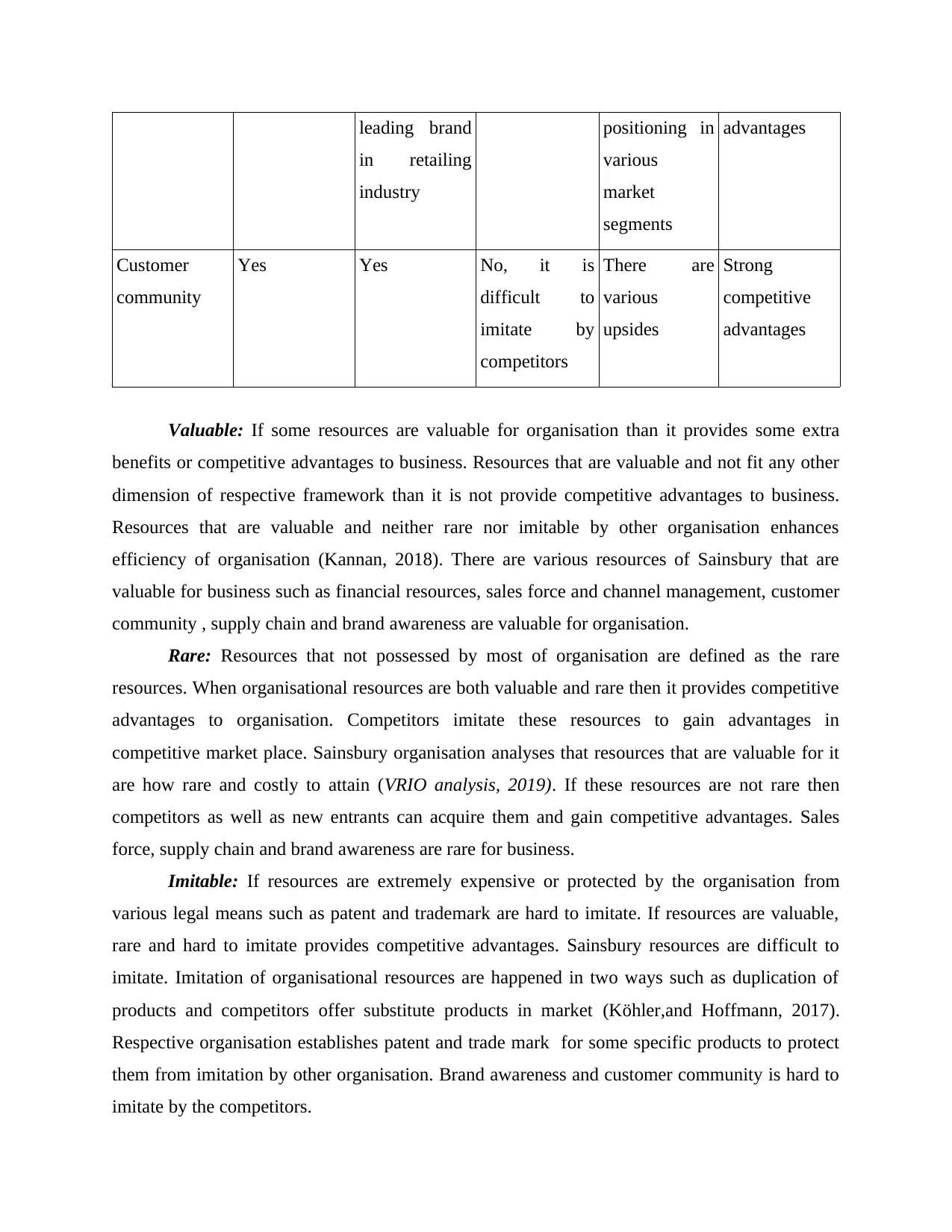
leading brand
in retailing
industry
positioning in
various
market
segments
advantages
Customer
community
Yes Yes No, it is
difficult to
imitate by
competitors
There are
various
upsides
Strong
competitive
advantages
Valuable: If some resources are valuable for organisation than it provides some extra
benefits or competitive advantages to business. Resources that are valuable and not fit any other
dimension of respective framework than it is not provide competitive advantages to business.
Resources that are valuable and neither rare nor imitable by other organisation enhances
efficiency of organisation (Kannan, 2018). There are various resources of Sainsbury that are
valuable for business such as financial resources, sales force and channel management, customer
community , supply chain and brand awareness are valuable for organisation.
Rare: Resources that not possessed by most of organisation are defined as the rare
resources. When organisational resources are both valuable and rare then it provides competitive
advantages to organisation. Competitors imitate these resources to gain advantages in
competitive market place. Sainsbury organisation analyses that resources that are valuable for it
are how rare and costly to attain (VRIO analysis, 2019). If these resources are not rare then
competitors as well as new entrants can acquire them and gain competitive advantages. Sales
force, supply chain and brand awareness are rare for business.
Imitable: If resources are extremely expensive or protected by the organisation from
various legal means such as patent and trademark are hard to imitate. If resources are valuable,
rare and hard to imitate provides competitive advantages. Sainsbury resources are difficult to
imitate. Imitation of organisational resources are happened in two ways such as duplication of
products and competitors offer substitute products in market (Köhler,and Hoffmann, 2017).
Respective organisation establishes patent and trade mark for some specific products to protect
them from imitation by other organisation. Brand awareness and customer community is hard to
imitate by the competitors.
in retailing
industry
positioning in
various
market
segments
advantages
Customer
community
Yes Yes No, it is
difficult to
imitate by
competitors
There are
various
upsides
Strong
competitive
advantages
Valuable: If some resources are valuable for organisation than it provides some extra
benefits or competitive advantages to business. Resources that are valuable and not fit any other
dimension of respective framework than it is not provide competitive advantages to business.
Resources that are valuable and neither rare nor imitable by other organisation enhances
efficiency of organisation (Kannan, 2018). There are various resources of Sainsbury that are
valuable for business such as financial resources, sales force and channel management, customer
community , supply chain and brand awareness are valuable for organisation.
Rare: Resources that not possessed by most of organisation are defined as the rare
resources. When organisational resources are both valuable and rare then it provides competitive
advantages to organisation. Competitors imitate these resources to gain advantages in
competitive market place. Sainsbury organisation analyses that resources that are valuable for it
are how rare and costly to attain (VRIO analysis, 2019). If these resources are not rare then
competitors as well as new entrants can acquire them and gain competitive advantages. Sales
force, supply chain and brand awareness are rare for business.
Imitable: If resources are extremely expensive or protected by the organisation from
various legal means such as patent and trademark are hard to imitate. If resources are valuable,
rare and hard to imitate provides competitive advantages. Sainsbury resources are difficult to
imitate. Imitation of organisational resources are happened in two ways such as duplication of
products and competitors offer substitute products in market (Köhler,and Hoffmann, 2017).
Respective organisation establishes patent and trade mark for some specific products to protect
them from imitation by other organisation. Brand awareness and customer community is hard to
imitate by the competitors.
Paraphrase This Document
Need a fresh take? Get an instant paraphrase of this document with our AI Paraphraser
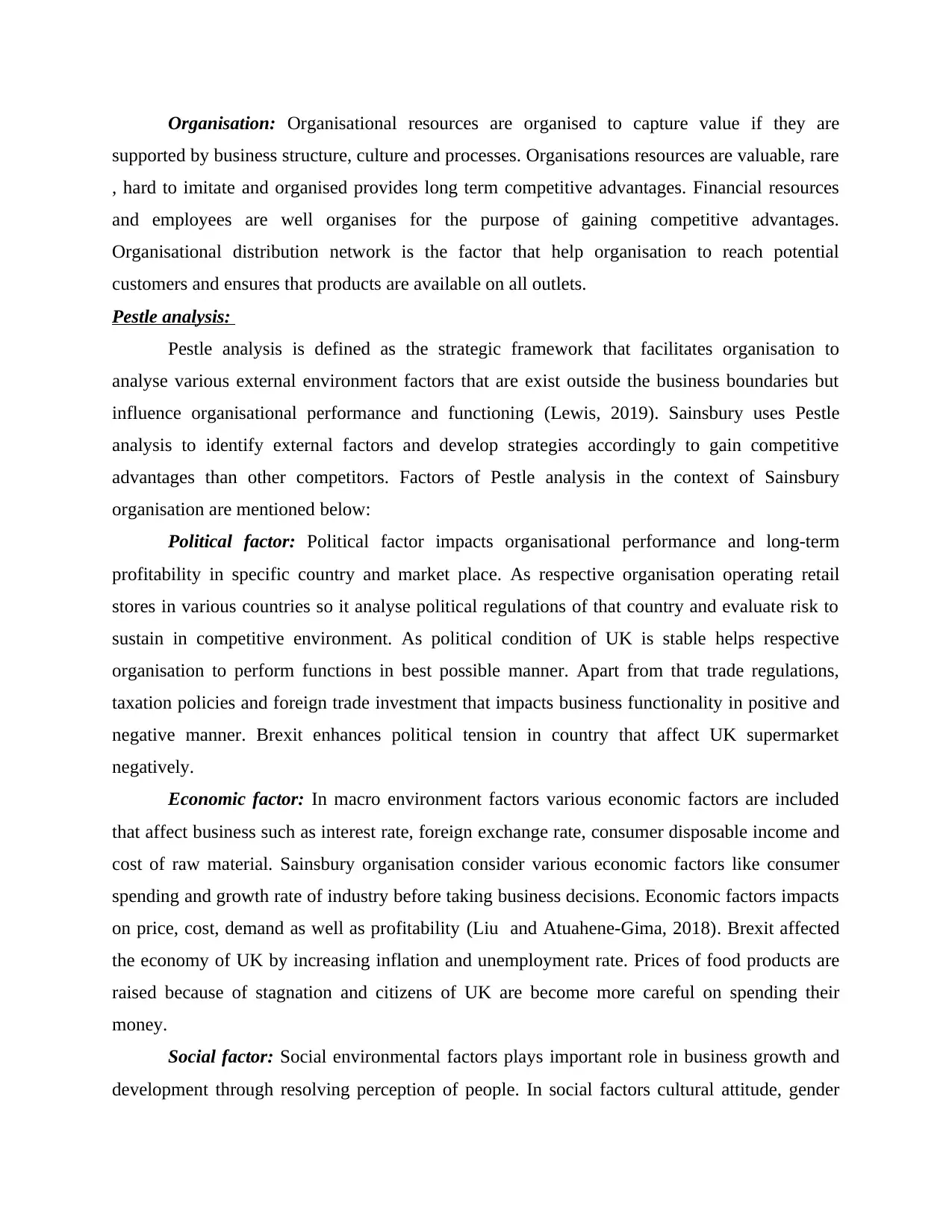
Organisation: Organisational resources are organised to capture value if they are
supported by business structure, culture and processes. Organisations resources are valuable, rare
, hard to imitate and organised provides long term competitive advantages. Financial resources
and employees are well organises for the purpose of gaining competitive advantages.
Organisational distribution network is the factor that help organisation to reach potential
customers and ensures that products are available on all outlets.
Pestle analysis:
Pestle analysis is defined as the strategic framework that facilitates organisation to
analyse various external environment factors that are exist outside the business boundaries but
influence organisational performance and functioning (Lewis, 2019). Sainsbury uses Pestle
analysis to identify external factors and develop strategies accordingly to gain competitive
advantages than other competitors. Factors of Pestle analysis in the context of Sainsbury
organisation are mentioned below:
Political factor: Political factor impacts organisational performance and long-term
profitability in specific country and market place. As respective organisation operating retail
stores in various countries so it analyse political regulations of that country and evaluate risk to
sustain in competitive environment. As political condition of UK is stable helps respective
organisation to perform functions in best possible manner. Apart from that trade regulations,
taxation policies and foreign trade investment that impacts business functionality in positive and
negative manner. Brexit enhances political tension in country that affect UK supermarket
negatively.
Economic factor: In macro environment factors various economic factors are included
that affect business such as interest rate, foreign exchange rate, consumer disposable income and
cost of raw material. Sainsbury organisation consider various economic factors like consumer
spending and growth rate of industry before taking business decisions. Economic factors impacts
on price, cost, demand as well as profitability (Liu and Atuahene-Gima, 2018). Brexit affected
the economy of UK by increasing inflation and unemployment rate. Prices of food products are
raised because of stagnation and citizens of UK are become more careful on spending their
money.
Social factor: Social environmental factors plays important role in business growth and
development through resolving perception of people. In social factors cultural attitude, gender
supported by business structure, culture and processes. Organisations resources are valuable, rare
, hard to imitate and organised provides long term competitive advantages. Financial resources
and employees are well organises for the purpose of gaining competitive advantages.
Organisational distribution network is the factor that help organisation to reach potential
customers and ensures that products are available on all outlets.
Pestle analysis:
Pestle analysis is defined as the strategic framework that facilitates organisation to
analyse various external environment factors that are exist outside the business boundaries but
influence organisational performance and functioning (Lewis, 2019). Sainsbury uses Pestle
analysis to identify external factors and develop strategies accordingly to gain competitive
advantages than other competitors. Factors of Pestle analysis in the context of Sainsbury
organisation are mentioned below:
Political factor: Political factor impacts organisational performance and long-term
profitability in specific country and market place. As respective organisation operating retail
stores in various countries so it analyse political regulations of that country and evaluate risk to
sustain in competitive environment. As political condition of UK is stable helps respective
organisation to perform functions in best possible manner. Apart from that trade regulations,
taxation policies and foreign trade investment that impacts business functionality in positive and
negative manner. Brexit enhances political tension in country that affect UK supermarket
negatively.
Economic factor: In macro environment factors various economic factors are included
that affect business such as interest rate, foreign exchange rate, consumer disposable income and
cost of raw material. Sainsbury organisation consider various economic factors like consumer
spending and growth rate of industry before taking business decisions. Economic factors impacts
on price, cost, demand as well as profitability (Liu and Atuahene-Gima, 2018). Brexit affected
the economy of UK by increasing inflation and unemployment rate. Prices of food products are
raised because of stagnation and citizens of UK are become more careful on spending their
money.
Social factor: Social environmental factors plays important role in business growth and
development through resolving perception of people. In social factors cultural attitude, gender
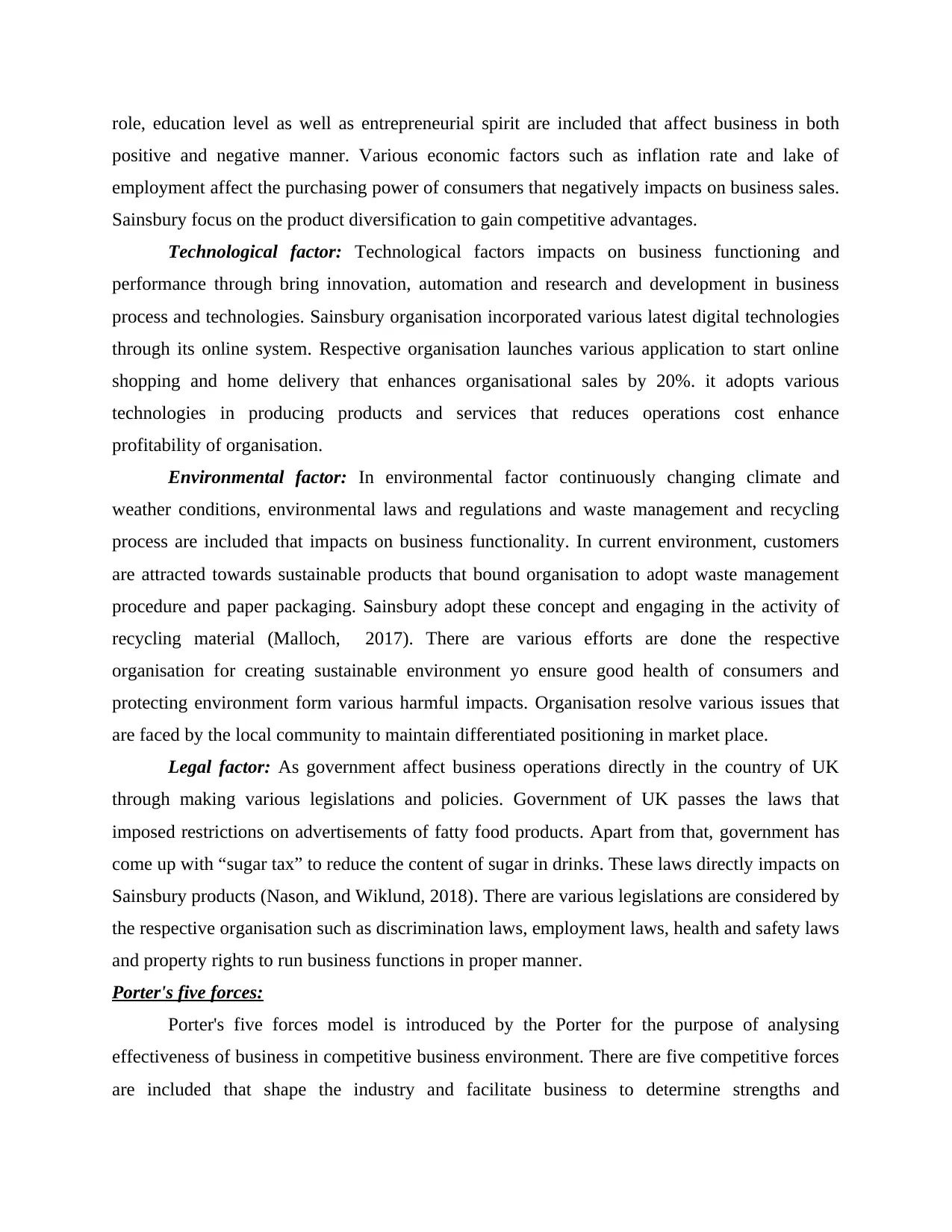
role, education level as well as entrepreneurial spirit are included that affect business in both
positive and negative manner. Various economic factors such as inflation rate and lake of
employment affect the purchasing power of consumers that negatively impacts on business sales.
Sainsbury focus on the product diversification to gain competitive advantages.
Technological factor: Technological factors impacts on business functioning and
performance through bring innovation, automation and research and development in business
process and technologies. Sainsbury organisation incorporated various latest digital technologies
through its online system. Respective organisation launches various application to start online
shopping and home delivery that enhances organisational sales by 20%. it adopts various
technologies in producing products and services that reduces operations cost enhance
profitability of organisation.
Environmental factor: In environmental factor continuously changing climate and
weather conditions, environmental laws and regulations and waste management and recycling
process are included that impacts on business functionality. In current environment, customers
are attracted towards sustainable products that bound organisation to adopt waste management
procedure and paper packaging. Sainsbury adopt these concept and engaging in the activity of
recycling material (Malloch, 2017). There are various efforts are done the respective
organisation for creating sustainable environment yo ensure good health of consumers and
protecting environment form various harmful impacts. Organisation resolve various issues that
are faced by the local community to maintain differentiated positioning in market place.
Legal factor: As government affect business operations directly in the country of UK
through making various legislations and policies. Government of UK passes the laws that
imposed restrictions on advertisements of fatty food products. Apart from that, government has
come up with “sugar tax” to reduce the content of sugar in drinks. These laws directly impacts on
Sainsbury products (Nason, and Wiklund, 2018). There are various legislations are considered by
the respective organisation such as discrimination laws, employment laws, health and safety laws
and property rights to run business functions in proper manner.
Porter's five forces:
Porter's five forces model is introduced by the Porter for the purpose of analysing
effectiveness of business in competitive business environment. There are five competitive forces
are included that shape the industry and facilitate business to determine strengths and
positive and negative manner. Various economic factors such as inflation rate and lake of
employment affect the purchasing power of consumers that negatively impacts on business sales.
Sainsbury focus on the product diversification to gain competitive advantages.
Technological factor: Technological factors impacts on business functioning and
performance through bring innovation, automation and research and development in business
process and technologies. Sainsbury organisation incorporated various latest digital technologies
through its online system. Respective organisation launches various application to start online
shopping and home delivery that enhances organisational sales by 20%. it adopts various
technologies in producing products and services that reduces operations cost enhance
profitability of organisation.
Environmental factor: In environmental factor continuously changing climate and
weather conditions, environmental laws and regulations and waste management and recycling
process are included that impacts on business functionality. In current environment, customers
are attracted towards sustainable products that bound organisation to adopt waste management
procedure and paper packaging. Sainsbury adopt these concept and engaging in the activity of
recycling material (Malloch, 2017). There are various efforts are done the respective
organisation for creating sustainable environment yo ensure good health of consumers and
protecting environment form various harmful impacts. Organisation resolve various issues that
are faced by the local community to maintain differentiated positioning in market place.
Legal factor: As government affect business operations directly in the country of UK
through making various legislations and policies. Government of UK passes the laws that
imposed restrictions on advertisements of fatty food products. Apart from that, government has
come up with “sugar tax” to reduce the content of sugar in drinks. These laws directly impacts on
Sainsbury products (Nason, and Wiklund, 2018). There are various legislations are considered by
the respective organisation such as discrimination laws, employment laws, health and safety laws
and property rights to run business functions in proper manner.
Porter's five forces:
Porter's five forces model is introduced by the Porter for the purpose of analysing
effectiveness of business in competitive business environment. There are five competitive forces
are included that shape the industry and facilitate business to determine strengths and
⊘ This is a preview!⊘
Do you want full access?
Subscribe today to unlock all pages.

Trusted by 1+ million students worldwide
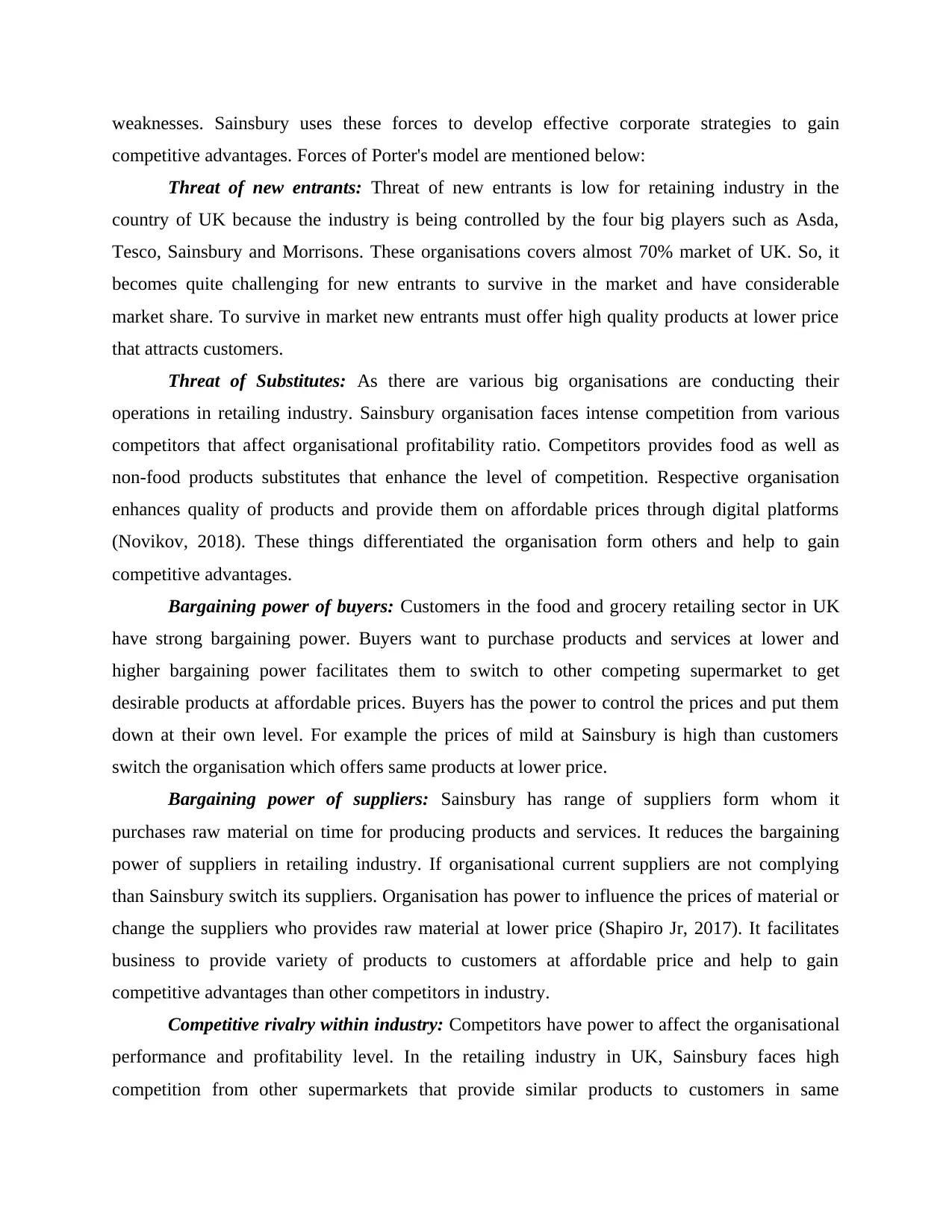
weaknesses. Sainsbury uses these forces to develop effective corporate strategies to gain
competitive advantages. Forces of Porter's model are mentioned below:
Threat of new entrants: Threat of new entrants is low for retaining industry in the
country of UK because the industry is being controlled by the four big players such as Asda,
Tesco, Sainsbury and Morrisons. These organisations covers almost 70% market of UK. So, it
becomes quite challenging for new entrants to survive in the market and have considerable
market share. To survive in market new entrants must offer high quality products at lower price
that attracts customers.
Threat of Substitutes: As there are various big organisations are conducting their
operations in retailing industry. Sainsbury organisation faces intense competition from various
competitors that affect organisational profitability ratio. Competitors provides food as well as
non-food products substitutes that enhance the level of competition. Respective organisation
enhances quality of products and provide them on affordable prices through digital platforms
(Novikov, 2018). These things differentiated the organisation form others and help to gain
competitive advantages.
Bargaining power of buyers: Customers in the food and grocery retailing sector in UK
have strong bargaining power. Buyers want to purchase products and services at lower and
higher bargaining power facilitates them to switch to other competing supermarket to get
desirable products at affordable prices. Buyers has the power to control the prices and put them
down at their own level. For example the prices of mild at Sainsbury is high than customers
switch the organisation which offers same products at lower price.
Bargaining power of suppliers: Sainsbury has range of suppliers form whom it
purchases raw material on time for producing products and services. It reduces the bargaining
power of suppliers in retailing industry. If organisational current suppliers are not complying
than Sainsbury switch its suppliers. Organisation has power to influence the prices of material or
change the suppliers who provides raw material at lower price (Shapiro Jr, 2017). It facilitates
business to provide variety of products to customers at affordable price and help to gain
competitive advantages than other competitors in industry.
Competitive rivalry within industry: Competitors have power to affect the organisational
performance and profitability level. In the retailing industry in UK, Sainsbury faces high
competition from other supermarkets that provide similar products to customers in same
competitive advantages. Forces of Porter's model are mentioned below:
Threat of new entrants: Threat of new entrants is low for retaining industry in the
country of UK because the industry is being controlled by the four big players such as Asda,
Tesco, Sainsbury and Morrisons. These organisations covers almost 70% market of UK. So, it
becomes quite challenging for new entrants to survive in the market and have considerable
market share. To survive in market new entrants must offer high quality products at lower price
that attracts customers.
Threat of Substitutes: As there are various big organisations are conducting their
operations in retailing industry. Sainsbury organisation faces intense competition from various
competitors that affect organisational profitability ratio. Competitors provides food as well as
non-food products substitutes that enhance the level of competition. Respective organisation
enhances quality of products and provide them on affordable prices through digital platforms
(Novikov, 2018). These things differentiated the organisation form others and help to gain
competitive advantages.
Bargaining power of buyers: Customers in the food and grocery retailing sector in UK
have strong bargaining power. Buyers want to purchase products and services at lower and
higher bargaining power facilitates them to switch to other competing supermarket to get
desirable products at affordable prices. Buyers has the power to control the prices and put them
down at their own level. For example the prices of mild at Sainsbury is high than customers
switch the organisation which offers same products at lower price.
Bargaining power of suppliers: Sainsbury has range of suppliers form whom it
purchases raw material on time for producing products and services. It reduces the bargaining
power of suppliers in retailing industry. If organisational current suppliers are not complying
than Sainsbury switch its suppliers. Organisation has power to influence the prices of material or
change the suppliers who provides raw material at lower price (Shapiro Jr, 2017). It facilitates
business to provide variety of products to customers at affordable price and help to gain
competitive advantages than other competitors in industry.
Competitive rivalry within industry: Competitors have power to affect the organisational
performance and profitability level. In the retailing industry in UK, Sainsbury faces high
competition from other supermarkets that provide similar products to customers in same
Paraphrase This Document
Need a fresh take? Get an instant paraphrase of this document with our AI Paraphraser
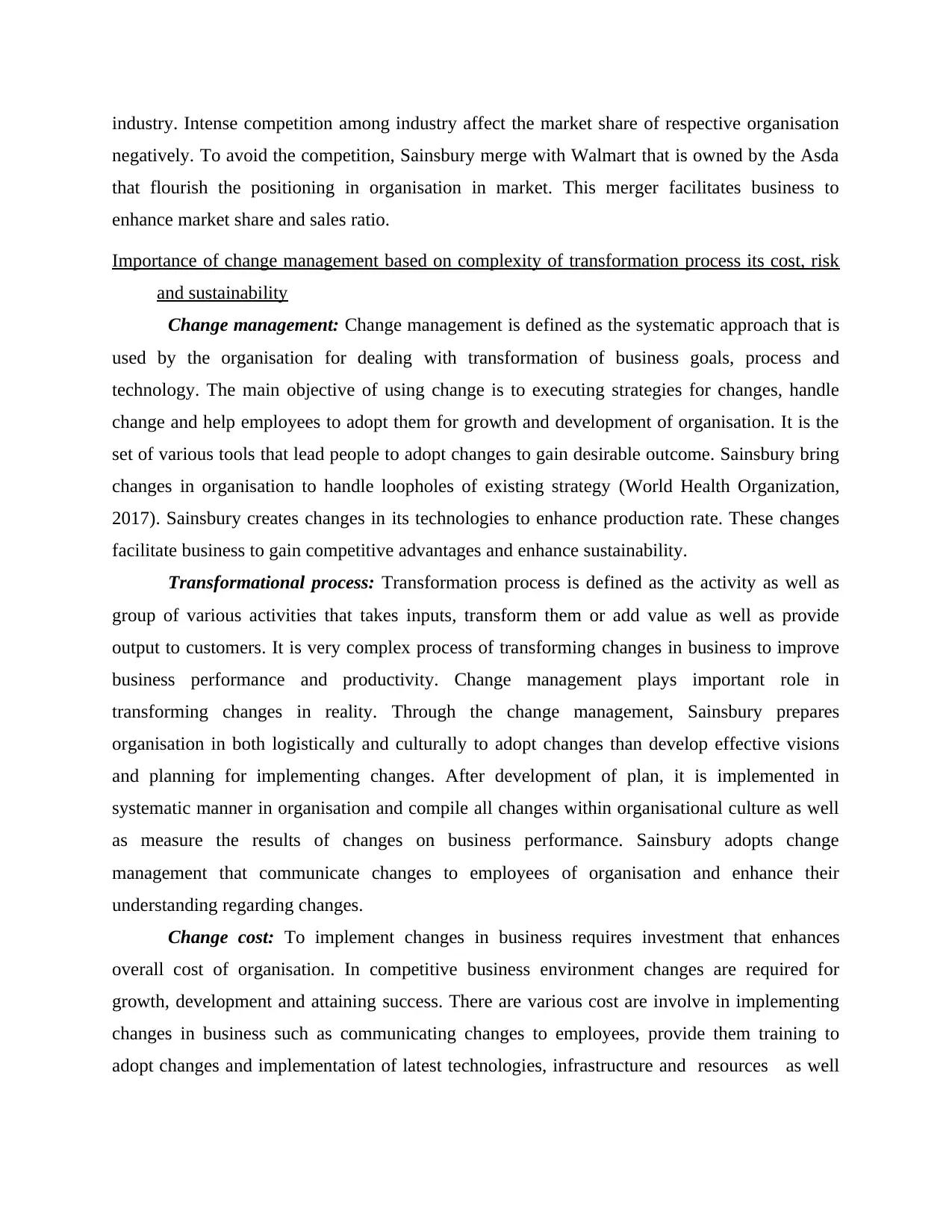
industry. Intense competition among industry affect the market share of respective organisation
negatively. To avoid the competition, Sainsbury merge with Walmart that is owned by the Asda
that flourish the positioning in organisation in market. This merger facilitates business to
enhance market share and sales ratio.
Importance of change management based on complexity of transformation process its cost, risk
and sustainability
Change management: Change management is defined as the systematic approach that is
used by the organisation for dealing with transformation of business goals, process and
technology. The main objective of using change is to executing strategies for changes, handle
change and help employees to adopt them for growth and development of organisation. It is the
set of various tools that lead people to adopt changes to gain desirable outcome. Sainsbury bring
changes in organisation to handle loopholes of existing strategy (World Health Organization,
2017). Sainsbury creates changes in its technologies to enhance production rate. These changes
facilitate business to gain competitive advantages and enhance sustainability.
Transformational process: Transformation process is defined as the activity as well as
group of various activities that takes inputs, transform them or add value as well as provide
output to customers. It is very complex process of transforming changes in business to improve
business performance and productivity. Change management plays important role in
transforming changes in reality. Through the change management, Sainsbury prepares
organisation in both logistically and culturally to adopt changes than develop effective visions
and planning for implementing changes. After development of plan, it is implemented in
systematic manner in organisation and compile all changes within organisational culture as well
as measure the results of changes on business performance. Sainsbury adopts change
management that communicate changes to employees of organisation and enhance their
understanding regarding changes.
Change cost: To implement changes in business requires investment that enhances
overall cost of organisation. In competitive business environment changes are required for
growth, development and attaining success. There are various cost are involve in implementing
changes in business such as communicating changes to employees, provide them training to
adopt changes and implementation of latest technologies, infrastructure and resources as well
negatively. To avoid the competition, Sainsbury merge with Walmart that is owned by the Asda
that flourish the positioning in organisation in market. This merger facilitates business to
enhance market share and sales ratio.
Importance of change management based on complexity of transformation process its cost, risk
and sustainability
Change management: Change management is defined as the systematic approach that is
used by the organisation for dealing with transformation of business goals, process and
technology. The main objective of using change is to executing strategies for changes, handle
change and help employees to adopt them for growth and development of organisation. It is the
set of various tools that lead people to adopt changes to gain desirable outcome. Sainsbury bring
changes in organisation to handle loopholes of existing strategy (World Health Organization,
2017). Sainsbury creates changes in its technologies to enhance production rate. These changes
facilitate business to gain competitive advantages and enhance sustainability.
Transformational process: Transformation process is defined as the activity as well as
group of various activities that takes inputs, transform them or add value as well as provide
output to customers. It is very complex process of transforming changes in business to improve
business performance and productivity. Change management plays important role in
transforming changes in reality. Through the change management, Sainsbury prepares
organisation in both logistically and culturally to adopt changes than develop effective visions
and planning for implementing changes. After development of plan, it is implemented in
systematic manner in organisation and compile all changes within organisational culture as well
as measure the results of changes on business performance. Sainsbury adopts change
management that communicate changes to employees of organisation and enhance their
understanding regarding changes.
Change cost: To implement changes in business requires investment that enhances
overall cost of organisation. In competitive business environment changes are required for
growth, development and attaining success. There are various cost are involve in implementing
changes in business such as communicating changes to employees, provide them training to
adopt changes and implementation of latest technologies, infrastructure and resources as well
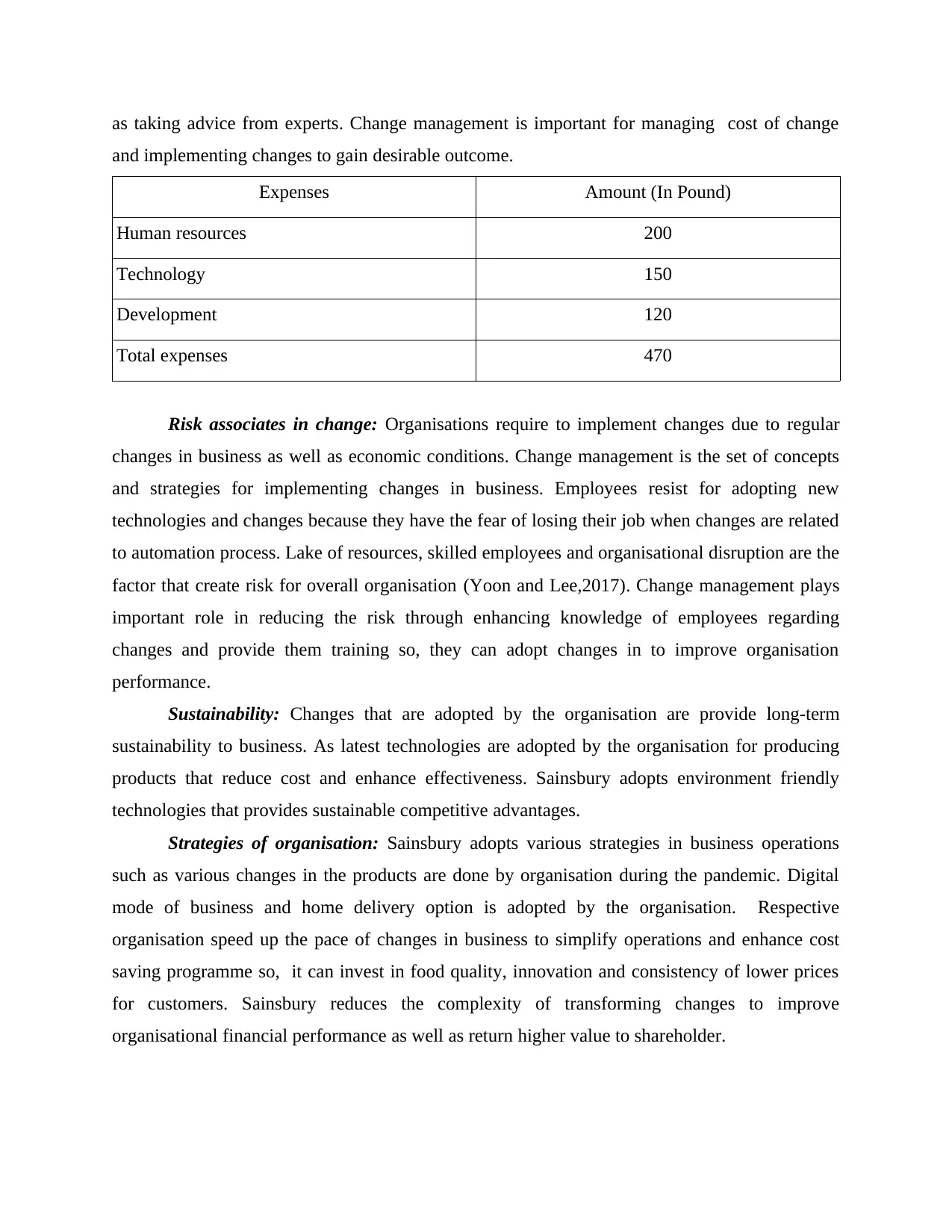
as taking advice from experts. Change management is important for managing cost of change
and implementing changes to gain desirable outcome.
Expenses Amount (In Pound)
Human resources 200
Technology 150
Development 120
Total expenses 470
Risk associates in change: Organisations require to implement changes due to regular
changes in business as well as economic conditions. Change management is the set of concepts
and strategies for implementing changes in business. Employees resist for adopting new
technologies and changes because they have the fear of losing their job when changes are related
to automation process. Lake of resources, skilled employees and organisational disruption are the
factor that create risk for overall organisation (Yoon and Lee,2017). Change management plays
important role in reducing the risk through enhancing knowledge of employees regarding
changes and provide them training so, they can adopt changes in to improve organisation
performance.
Sustainability: Changes that are adopted by the organisation are provide long-term
sustainability to business. As latest technologies are adopted by the organisation for producing
products that reduce cost and enhance effectiveness. Sainsbury adopts environment friendly
technologies that provides sustainable competitive advantages.
Strategies of organisation: Sainsbury adopts various strategies in business operations
such as various changes in the products are done by organisation during the pandemic. Digital
mode of business and home delivery option is adopted by the organisation. Respective
organisation speed up the pace of changes in business to simplify operations and enhance cost
saving programme so, it can invest in food quality, innovation and consistency of lower prices
for customers. Sainsbury reduces the complexity of transforming changes to improve
organisational financial performance as well as return higher value to shareholder.
and implementing changes to gain desirable outcome.
Expenses Amount (In Pound)
Human resources 200
Technology 150
Development 120
Total expenses 470
Risk associates in change: Organisations require to implement changes due to regular
changes in business as well as economic conditions. Change management is the set of concepts
and strategies for implementing changes in business. Employees resist for adopting new
technologies and changes because they have the fear of losing their job when changes are related
to automation process. Lake of resources, skilled employees and organisational disruption are the
factor that create risk for overall organisation (Yoon and Lee,2017). Change management plays
important role in reducing the risk through enhancing knowledge of employees regarding
changes and provide them training so, they can adopt changes in to improve organisation
performance.
Sustainability: Changes that are adopted by the organisation are provide long-term
sustainability to business. As latest technologies are adopted by the organisation for producing
products that reduce cost and enhance effectiveness. Sainsbury adopts environment friendly
technologies that provides sustainable competitive advantages.
Strategies of organisation: Sainsbury adopts various strategies in business operations
such as various changes in the products are done by organisation during the pandemic. Digital
mode of business and home delivery option is adopted by the organisation. Respective
organisation speed up the pace of changes in business to simplify operations and enhance cost
saving programme so, it can invest in food quality, innovation and consistency of lower prices
for customers. Sainsbury reduces the complexity of transforming changes to improve
organisational financial performance as well as return higher value to shareholder.
⊘ This is a preview!⊘
Do you want full access?
Subscribe today to unlock all pages.

Trusted by 1+ million students worldwide
1 out of 14
Related Documents
Your All-in-One AI-Powered Toolkit for Academic Success.
+13062052269
info@desklib.com
Available 24*7 on WhatsApp / Email
![[object Object]](/_next/static/media/star-bottom.7253800d.svg)
Unlock your academic potential
Copyright © 2020–2025 A2Z Services. All Rights Reserved. Developed and managed by ZUCOL.





